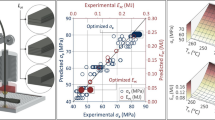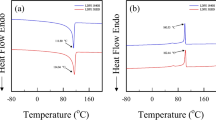Abstract
Manufacturing processes significantly influence microstructural variations in short fiber reinforced composites, which affect damage characteristics and fatigue life. Accurate fatigue life prediction is critical, especially when considering the impact of these manufacturing induced microstructural nuances. In this study, we investigate how manufacturing processes shape microstructures and their impact on fatigue life prediction. We present an advanced micromechanical model for predicting fatigue life in tangible structures, considering the microstructure distribution influenced by manufacturing dynamics. Our model links damage from monotonic loading to fatigue life, resulting in a multi-scale fatigue prediction model. This approach builds a database revealing the interaction between Tsai-Wu failure criterion parameters, manufacturing-induced microstructural variations, and target fatigue life. Using these insights, we fine-tune material properties in finite element simulations for precise design optimization. We illustrate our method using an automotive tailgate made from a sheet molding compound. This research highlights the critical role of manufacturing processes in microstructure variation and fatigue life prediction. It offers the potential for significant vehicle weight reduction, energy savings, and reduced emissions in automotive design and promises to be a valuable tool for optimizing manufacturing process parameters.


















Similar content being viewed by others
Data availability
The authors declare that the data and the materials of this study are available within the article.
References
Hangs B, Bücheler D, Karcher M, Henning F (n.d.) High-volume production of structural automobile parts: comparative study of relevant com
Bruderick M, Denton D, Shinedling M (2013) Applications of carbon fiber SMC for the dodge viper. Proceedings to Automotive Composites Conference & Exhibition (ACCE), Detroit
Yang X, Liu L, Wang Y (2022) Random fatigue life prediction of automobile lower arm via modified Corten–Dolan model. Fatigue Fract Eng Mater Struct
Shirinbayan M, Fitoussi J, Abbasnezhad N, Meraghni F, Surowiec B, Tcharkhtchi A (2017) Mechanical characterization of a low density sheet molding compound (LD-SMC): multi-scale damage analysis and strain rate effect. Compos Part B 131
Bernasconi A, Cosmi F, Dreossi D (2008) Local anisotropy analysis of injection moulded fiber reinforced polymer composites. Compos Sci Technol 68:2574–2581
Meraghni F, Benzeggagh ML (1995) Micromechanical modelling of matrix degradation in randomly oriented discontinuous-fibre composites. Compos Sci Technol 55(2):171–186. https://doi.org/10.1016/0266-3538(95)00096-8
Jendli Z, Meraghni F, Fitoussi J, Baptiste D (2004) Micromechanical analysis of strain rate effect on damage evolution in sheet molding compound composites. Compos Appl Sci Manuf 35(7–8):779–785. https://doi.org/10.1016/j.compositesa.2004.01.020
Ben CheikhLarbi A, Sai K, Sidhom H, Baptiste D (2006) Constitutive model of micro-mechanical damage to predict reduction in stiffness of a fatigued SMC composite. J Mater Eng Perform 15(5):575–580. https://doi.org/10.1361/105994906X124569
Fitoussi J, Bocquet M, Meraghni F (2013) Effect of the matrix behavior on the damage of ethylene-propylene glass fiber reinforced composite subjected to high strain rate tension. Compos B Eng 45(1):1181–1191. https://doi.org/10.1016/j.compositesb.2012.06.011
Fitoussi J, Meraghni F, Jendli Z, Hug G, Baptiste D (2005) Experimental methodology for high strain-rates tensile behaviour analysis of polymer matrix composites. Compos Sci Technol 65(14):2174–2188. https://doi.org/10.1016/j.compscitech.2005.05.001
Jendli Z, Fitoussi J, Meraghni F, Baptiste D (2005) Anisotropic strain rate effects on the fibre-matrix interface decohesion in sheet moldingcompound composites. Compos Sci Technol 65(3–4):387–393. https://doi.org/10.1016/j.compscitech.2004.09.027
Shirinbayan M, Fitoussi J, Meraghni F, Surowiec B, Bocquet M, Tcharkhtchi A (2015) High strain rate visco-damageable behavior of advanced sheet molding compound (A-SMC) under tension. Compos B Eng 82:30–41. https://doi.org/10.1016/j.compositesb.2015.07.010
Al Jahwari F, Naguib HE (2016) Finite element creep prediction of polymeric voided composites with 3D statistical-based equivalent microstructure reconstruction. Compos Part B 99
Ren M, Cong J, Wang Bo, Wang L (2018) Extended multiscale finite element method for large deflection analysis of thin-walled composite structures with complicated microstructure characteristics. Thin-Walled Structures 130:273–285. https://doi.org/10.1016/j.tws.2018.05.021
Fitoussi J, Bourgeois N, Guo G, Baptiste D (1996) Prediction of the anisotropic damaged behavior of composite materials: introduction of multilocal failure criteria in a micro-macro relationship. Comput Mater Sci 5:87–100. https://doi.org/10.1016/0927-0256(95)00061-5
Fitoussi J, Guo G, Baptiste D (1996) Determination of a tridimensional failure criterion at the fibre/matrix interface of an organic-matrix/discontinuous-reinforcement composite. Compos Sci Technol 56(7):755–760. https://doi.org/10.1016/0266-3538(96)00017-6
Fitoussi J, Guo G, Baptiste D (1998) A statistical micromechanical model of anisotropic damage for S.M.C. composites. Compos Sci Technol 58(5):759–763. https://doi.org/10.1016/S0266-3538(97)00163-2
Meraghni F, Blakeman CJ, Benzeggagh ML (1996) Effect of interfacial decohesion on stiffness reduction in a random discontinuous-fibre composite containing matrix microcracks. Compos Sci Technol 56(5):541–555. https://doi.org/10.1016/0266-3538(96)00039-5
Derrien K, Fitoussi J, Guo G, Baptiste D (2000) Prediction of the effective damage properties and failure properties of nonlinear anisotropic discontinuous reinforced composites. Comput Meth Appl Mech Eng 185(2–4):93–107. https://doi.org/10.1016/S0045-7825(99)00253-4
Desrumaux F, Meraghni F, Benzeggagh ML (2000) Micromechanical modelling coupled to a reliability approach for damage evolution prediction in composite material. Appl Compos Mater 7(4):231–250. https://doi.org/10.1023/A:1008959400978
Meraghni F, Desrumaux F, Benzeggagh ML (2002) Implementation of a constitutive micromechanical model for damage analysis in glass mat reinforced composite structures. Compos Sci Technol 62(16):2087–2097. https://doi.org/10.1016/S0266-3538(02)00110-0
Desrumaux F, Meraghni F, Benzeggagh ML (2001) Generalised mori-tanaka scheme to model anisotropic damage using numerical Eshelby tensor. J Compos Mater 35:603–624. https://doi.org/10.1177/002199801772662091
Jendli Z, Meraghni F, Fitoussi J, Baptiste D (2009) Multi-scales modelling of dynamic behaviour for discontinuous fibre SMC composites. Compos Sci Technol 69(1):97–103. https://doi.org/10.1016/j.compscitech.2007.10.047
Kammoun S, Doghri I, Brassart L, Delannay L (2015) Micromechanical modeling of the progressive failure in short glass-fiber reinforced thermoplastics - first pseudo-grain damage model. Compos Appl Sci Manuf 73:166–175. https://doi.org/10.1016/j.compositesa.2015.02.017
Guo G, Fitoussi J, Baptiste D (1997) Modelling of damage behavior of a short-fiber reinforced composite structure by the finite element analysis using a micro-macro law. Int J Damage Mech 6:278–299 (0803973233)
Nguyen BN, Khaleel MA (2004) A mechanistic approach to damage in short-fiber composites based on micromechanical and continuum damage mechanics descriptions. Compos Sci Technol 64(5):607–617. https://doi.org/10.1016/S0266-3538(03)00293-8
Baptiste D (2003) Nonlinear behavior micromechanical multi-scale modelling of discontinuous reinforced composites. Mater Sci Forum 426–432:3939–3944. https://doi.org/10.4028/www.scientific.net/MSF.426-432.3939
Yang W, Pan Y, Pelegri AA (2012) Multiscale modeling of matrix cracking coupled with interfacial debonding in random glass fiber composites based on volume elements. J Compos Mater 47(27):3389–3399. https://doi.org/10.1177/0021998312465977
Notta-Cuvier D, Lauro F, Bennani B (2014) Modelling of progressive fibre/matrix de- bonding in short-fibre reinforced composites up to failure. Int J Solid Struct 66:140–150. https://doi.org/10.1016/j.ijsolstr.2015.03.034
Laribi MA, Tamboura S, Fitoussi J, Tié Bi R, Tcharkhtchi A, Ben Dali H (2018) Fast fatigue life prediction of short fiber reinforced composites using a new hybrid damage approach: application to SMC. Compos Part B: Engineering 139:155–162. https://doi.org/10.1016/j.compositesb.2017.11.063
Liua X-T, Wanga H-J, Yanga X-B, Laib J-F (n.d.) Prediction and evaluation of fatigue strength via mechanical behavior of materials. J Chin Soc Mech Eng 43(3):229–238
De Monte M, Moosbrugger E, Quaresimin M (2010) Influence of temperature and thickness on the off-axis behaviour of short glass fiber reinforced polyamide 6.6–cyclic loading. Compos Part A: Appl Sci Manuf 41(10):1368–79
Nouri H, Meraghni F, Lory P (2009) Fatigue damage model for injection-molded short glass fiber reinforced thermoplastics. Int J Fatigue 31(5):934–942
Ladèveze P, LeDantec E (1992) Damage modelling of the elementary ply for laminated composites. Compos Sci Technol 43(3):257–267
Meraghni F, Nouri H, Bourgeois N, Czarnota C, Lory P (2011) Parameters identification of fatigue damage model for short glass fiber reinforced polyamide (PA6-GF30) using digital image correlation. Proc Eng 10:2110–2116
Meftah H, Tamboura S, Fitoussi J, Bendaly H, Tcharkhtchi A (2018) Characterization of a new fully recycled carbon fiber reinforced composite subjected to high strain rate tension, 2017. Appl Compos Mater 25(3):507–526
Kachanov LM (1976) On subcritical crack growth. Mech Res Commun 3(1):51–54
Laribi MA, Tamboura S, Fitoussi J, Shirinbayan M, Tie Bi R, Tcharkhtchi A, Ben Dali H (n.d.) Microstructure dependent fatigue life prediction for short fibers reinforced composites: application to sheet molding compounds (Submitted in Composites Part B)
Ayari H, Fitoussi J, Imaddahen A, Tamboura S, Shirinbayan M, Dali HB, Tcharkhtchi A (2020) Two hybrid approaches to fatigue modeling of advanced-sheet molding compounds (A-SMC) composite. Appl Compos Mater 27(1–2):19–36
Zhang L, Liu Z, Wu D, Zhang H, Zhu P (2023) Fast and synergetic fatigue life prediction of short fiber reinforced polymer composites from monotonic and cyclic loading behavior. Compos Sci Technol 241
Shirinbayan M, Fitoussi J, Meraghni F, Surowiec B, Laribi M, Tcharkhtchi A (2016) Coupled effect of loading frequency and amplitude on the fatigue behavior of advanced sheet molding compound (A- SMC). J Reinf Plast Compos (JRP)
Tamboura S, Sidhom H, Baptiste D (2001) Evaluation de la tenue en fatigue du composite SMC R42. Matériaux et Techniques 3–4:3–11
Schemmann M, Görthofer J, Seelig T, Hrymak A, Böhlke T (2018) Anisotropic meanfield modeling of debonding and matrix damage in SMC composites. Compos Sci Technol 161:143–158. https://doi.org/10.1016/j.compscitech.2018.03.041
Baney JM, Zhao YH, Weng GJ (1996) Progressive debonding of aligned oblate inclusions and loss of stiffness in a brittle matrix composite. Eng Fract Mech 53:897–910. https://doi.org/10.1016/0013-7944(95)00211-1
Zairi F, Nait-Abdelaziz M, Gloaguen JM, Bouaziz A, Lefebvre J-M (2008) Micromechanical modelling and simulation of chopped random fiber reinforced polymer composites with progressive debonding damage. Int J Solids Struct 45:5220–5236
Formica G, Lacarbonara W (2013) Damage model of carbon nanotubes debonding in nanocomposites. Compos Struct 96:514–525. https://doi.org/10.1016/j.compstruct.2012.08.049
Mori T, Tanaka K (1973) Average stress in matrix and average elastic energy ofmaterials with misfitting inclusions. Acta Metall 21:571–574
Li S, Sitnikova E (2018) A critical review on the rationality of popular failure criteria for composites. Compos Commun 8:7–13. https://doi.org/10.1016/j.coco.2018.02.002
Mortazavian S, Fatemi A (2015) Fatigue behavior and modeling of short fiber reinforced polymercomposites including anisotropy and temperature effects. Int J Fatigue 77:12–27
Author information
Authors and Affiliations
Contributions
JF, MAL, and MS: construct the idea. JF, SN, KB, MAL, AK, RTB, and MS: analyzed results, draft manuscript preparation, and wrote the paper. JF, SN, KB, MAL, AK, RTB, and MS: corrected the English and the paper format.
Corresponding author
Ethics declarations
Consent to participate
Not applicable.
Consent for publication
Not applicable.
Conflict of interest
The authors declare no competing interests.
Additional information
Publisher's Note
Springer Nature remains neutral with regard to jurisdictional claims in published maps and institutional affiliations.
Rights and permissions
Springer Nature or its licensor (e.g. a society or other partner) holds exclusive rights to this article under a publishing agreement with the author(s) or other rightsholder(s); author self-archiving of the accepted manuscript version of this article is solely governed by the terms of such publishing agreement and applicable law.
About this article
Cite this article
Fitoussi, J., Nouira, S., Benfriha, K. et al. Investigation of manufacturing process effects on microstructure and fatigue prediction in composite automotive tailgate design. Int J Adv Manuf Technol 130, 4295–4310 (2024). https://doi.org/10.1007/s00170-024-12988-z
Received:
Accepted:
Published:
Issue Date:
DOI: https://doi.org/10.1007/s00170-024-12988-z




